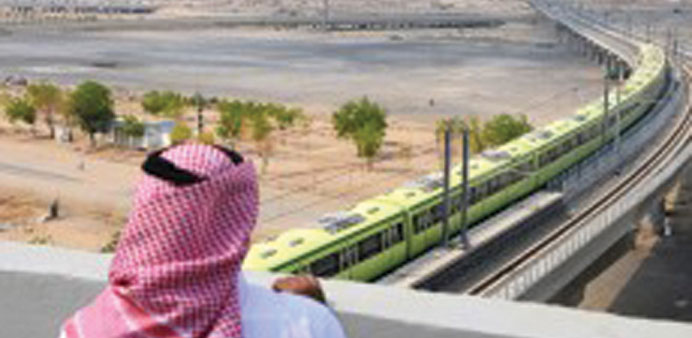Oman wants to push on with its leg of the Gulf Co-operation Council Railway due to stretch 1,350 miles from the borders of Iraq to the shores of the Indian Ocean by 2018
Bloomberg/Dubai
Oman, which faces Iran across the Strait of Hormuz, has said it is poised to start raising cash for a $3bn rail line offering an alternative route for oil and freight shipments that funnel through the 21 mile-wide channel.
The nation of 3.3mn people, located on the southern side of the strait, is considering issuing bonds by the end of 2014 to kick-start funding for the track across some of the Arabian Peninsula’s harshest terrain, Abdulrahman al-Hatmi, a director at Oman National Railway Co, said in an interview.
Iranian threats to close the Hormuz waterway have been a recurrent theme in Western relations with the Islamic republic since the 1979 revolution. While tensions have begun to ease after an interim deal aimed at halting Iran’s nuclear programme, al-Hatmi said the “very expensive” rail line is more than justified by the new trade opportunities bypassing the strait would offer Oman’s southern port of Salalah.
“We are moving fast now,” he said at a rail conference in Dubai. “One of the key changes we’ve made is to connect to Salalah, which is the mouth of the whole region and will play a major role in transforming the whole logistics map.”
Oman wants to push on with its leg of the Gulf Co-operation Council Railway due to stretch 1,350 miles from the borders of Iraq to the shores of the Indian Ocean by 2018 just as nations including Kuwait say they’ll struggle to meet agreed deadlines.
Oman last week signed a 13.6mn rial ($35mn) deal for design work with Italferr, the engineering arm of Italy’s state railway. Awards to construction companies will take place by the end of this year, with work commencing by the first quarter of 2015, al-Hatmi said.
Rather than hugging the coast to reach Oman, the line will take the shortest route east from Abu Dhabi on the Arabian Gulf, crossing the border from the UAE near Al Ain before plowing for 100 miles through the Hajar Mountains, which rise to 10,000ft, and reaching the ocean near Suhar, 150 miles north of Omani capital, Muscat.
The terrain makes the leg the most challenging of the GCC line and the bill may be higher than the current estimate, according to al-Hatmi, who said studies are under way to pin down the final cost. From Muscat, Oman wants the line to continue south across its arid interior to the ports of Duqum and Salalah, ending at the border with Yemen, he said.
By circumventing the Strait of Hormuz the railway would dilute the impact of further closure threats to a waterway through which some 20% of crude supplies pass to reach global markets, equal to 35% of seaborne traded oil, according to the US Energy Information Administration.
About 17mn barrels of oil passed through the channel each day in 2011, almost five times the total for the Suez Canal, the next busiest chokepoint, the EIA estimates.
The line’s scope for serving as an alternative route for crude exports will be determined by its proximity to oil fields and loading terminals and a need for thousands of tanker cars, according to Robin Mills, head of consulting at Manaar Energy Consulting & Project Management in Dubai, who said the link may come into its own in an emergency lasting at least six months.
Other means of bypassing the Strait of Hormuz include a 263-mile pipeline stretching from Abu Dhabi to the emirate of Fujairah on the Indian Ocean, built at a cost of $4.2bn. A second pipe carries Saudi oil from the Gulf across Arabia to the Red Sea, though the two routes could carry only a fraction of ship-borne crude capacity.
Oman will consider both conventional bonds and sukuk as funding options for the line, and could structure some contracts as public-private partnerships under which successful bidders would assume a high degree of financial and operating risk, al-Hatmi said. International investors are also offering to buy trains and lease them back to the government, he said.
The GCC Railway has a projected cost of $20bn and aims to provide a route spanning six Gulf countries by 2018. Work is most advanced in the UAE, where the seven emirates that form the nation are backing the railway to boost integration and ease pressure on congested roads.
Saudi Arabia has built 125 miles of track, a rail symposium in Riyadh was told last month. The Arab world’s largest economy will award a design contract for other sections of the line running from Kuwait to the UAE border in two months, with five companies bidding, Mohammad al-Suwaiket, president of the Saudi Railway Organisation, said in Dubai.
Progress in Kuwait has been far slower, with no consultant chosen to design 320 miles of track, said Mansour al-Bader, chairman of the country’s advisory committee on the project. A construction tender will be issued in about 18 months with the aim of finishing work three years after the contract has been awarded. That would likely be by the end of 2019, a year late, he said.
Qatar and Bahrain will be linked via a loop from the main line, requiring further major engineering projects. Talks are under way on building a causeway between the countries, and the GCC is evaluating a $4.2bn bridge that would carry the track to Bahrain from Saudi Arabia.
GCC ambitions stretch beyond a rail system simply reducing the bloc’s reliance on the Strait of Hormuz. The UAE public works minister, Abdullah al-Nuaimi, suggested in Dubai that a study be carried out into a link to Arab countries in the north creating a long-distance line to the borders of Europe.

